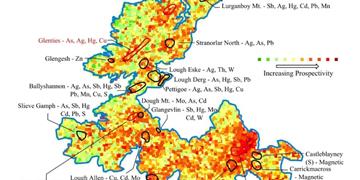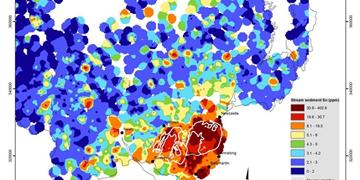Mineral prospectivity map of the border region of Ireland

Investigator(s): Omagh Minerals
Funder: EU INTERREG IVA -funded Tellus Border project
The Border region is underlain by a diverse geology and similar geological associations elsewhere have yielded a wide range of mineral prospects including gold, silver and base metals such as copper, lead and zinc. Some such prospects have already been established within the Border zone. Using Tellus Border geochemical and geophysical data along with information on bedrock lithology, age of bedrock and structural features such as NE trending faults and deep seated lineaments, four prospective areas were selected for further detailed sampling and mapping: Glenties and Millford in Co. Donegal; Manorhamilton in Co. Leitrim and Shercock in Co. Cavan. All four areas appeared prospective for gold, with Shercock and Glenties also exhibiting potential for base metal mineralisation. This work has informed discussions regarding genetic models for mineralisation has highlighted the highly prospective nature of the Border region, particularly for gold.
Download poster
Download report
Critical Metal potential of the Mourne Mountains

Investigator(s): University of Exeter, British Geological Survey, University of Brighton
Funder: EU INTERREG IVA -funded Tellus Border project
The manufacture of low-carbon and emerging modern technologies requires an increasingly wide range of elements, many of which have traditionally been used in very small quantities, but are highly valued for their chemical and physical properties. Currently production of many of these critical metals is concentrated in a small number of countries, frequently with political and social infrastructures that create a substantial supply risk. Accordingly, there is a requirement to identify new sources of supply. The Mourne Granites have compositions that suggest that they have the potential to be enriched in Rare Earth Elements and other critical metals. Heavy mineral concentrates, bedrock samples and grain-size analysis were used together with Tellus stream geochemical data in this study to indicate critical metal enrichments and enrichment processes in the Mourne Mountains.
Download report
Spatially constrained Bayesian inversion of frequency- and time-domain airborne electromagnetic data from the Tellus projects
Investigator: Dr Volker Rath, Dublin Institute for Advanced Studies
Funder: Geological Survey of Ireland Short Call 2015
A novel method for interpreting electromagnetic data from the Tellus surveys with 1-D layered subsurface models is developed, implemented in an open-source code, and tested on field data. Using Bayesian techniques and spatial constraints, the approach delivers estimates of uncertainty along with preferred conductivity-depth models for each site.
Download report
Integrated geological-geophysical model for stratiform Zn-Pb exploration
Investigator: Mr Tom Davitt, PGW Europe
Funder: Geological Survey of Ireland Short Call 2015
This project aims to provide better insight into the localization of stratabound and fault-controlled Zn-Pb deposits in Ireland. This will be achieved by creating a new regional integrated 3D litho-structural interpretation of geophysical datasets obtained from the Tellus (and related) surveys, as well as 2D section-based models of magnetic, gravity and EM datasets.
Download report
Using Tellus electromagnetic and geochemical datasets to improve soil mapping in Ireland
Investigator: Dr Mark Holdstock, Aurum Exploration
Funder: Geological Survey of Ireland Short Call 2015
The aim of this work is to classify Irish soil types based on their geochemical and geophysical characteristics. Working with GSI staff, our research will directly compare output from the airborne geophysical and ground geochemical components of the recent Tellus Border and Tellus North Midlands surveys with published geological information.
Download report
Geochemical anomaly detection: spatial analysis for improved use of geochemical data
Investigator: Mr Derek Reay, Geological Survey of Northern Ireland
Funder: Geological Survey of Ireland Short Call 2015
This project will compare two mathematical methods to detect geochemical anomalies. The first uses singularity theory, based on fractal models of variation. The second uses a robust geostatistical model to identify observations that contrast with background. This will facilitate novel use of Tellus data for mineral exploration and resource assessment.
Download report